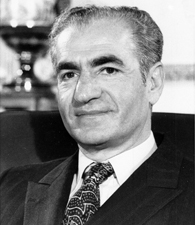Mohammad Reza Pahlavi was Shah of Iran for more than 30 years. His reforms transformed his country into a substantial Middle Eastern economic and military power, but his autocratic rule and corrupt regime eventually led to his downfall.
Mohammad Reza Pahlavi’s Early Days
Mohammad Reza Pahlavi was born on October 26, 1919, in Tehran, Iran. His father, Reza Shah Pahlavi, was a powerful military leader who became Shah of Iran in 1926 after a successful coup.
Mohammad Reza’s father implemented many radical reforms in Iran, including the disarming of warring tribes and the emancipation of women. At the age of six, Mohammad Reza officially became crown price of Iran and heir to his father’s throne.
Mohammad Reza attended a school in Switzerland for a few years; he returned to Iran in 1935 and enrolled in a Tehran military school. Mohammad Reza was strongly influenced by his father’s powerful demeanor, saying of his father, “Many men feared to look him in the eye.”
In 1939, Mohammad Reza married his first of three wives, Princess Fawzia of Egypt, a marriage that ended in divorce in 1949.
In 1941, Britain and the Soviet Union feared that Reza Shah’s relationship with Germany was becoming too close, so they invaded Iran and demanded that Reza Shah abdicate the throne. The 22-year-old Mohammad Reza was then named Shah of Iran. Although on paper the new shah’s power was limited, Mohammad Reza quickly learned how to manipulate those around him to gain influence in the Iranian government.
Sources in this Story
- Notable Biographies: Mohammad Reza Pahlavi
- Iran Chamber Society: Mohammad Reza Shah Pahlavi
- Encyclopedia Britannica: Mohammad Reza Shah Pahlavi
- Time magazine: Iran. The White Revolution
- The BBC: Shah of Iran flees into exile
The Shah’s Notable Accomplishments
In the 1940s, Iran’s peace was disrupted by civil conflicts, many of which stemmed from Communist and nationalist movements within the country. The unrest came to a head in 1949, when an assassination attempt was made on the shah. As a result, he began expanding his constitutional powers to rein in his opponents, but his efforts were thwarted by his rival, the popular nationalist Mohammad Mosaddeq.
In 1953, the shah was forced to flee Iran by Mohammad Mosaddeq’s supporters. After only a few days in exile, he returned to Iran and, allegedly with the secret help of U.S. forces, reclaimed power.
The shah’s reign throughout the 1960s was marked by radical social and political reform. The White Revolution, as it was known, involved the redistribution of private land to peasant farmers, a nationwide literacy campaign, and new women’s suffrage laws. In 1967, the shah crowned himself the emperor of Iran, essentially declaring himself heir to Iran’s ancient kings, an action which offended many.
His international visibility increased during this time as well, as the Western countries increasingly recognized the importance of the oil-rich Middle East. At this time, Iran had the strongest military in the Middle East, and the shah was seen as that region’s most powerful leader.
The Man and his Work
- “The Shah and I: The Confidential Diary of Iran’s Royal Court, 1968–77” by Asadollah Alam
- “Blood & Oil: A Prince’s Memoir of Iran, from the Shah to the Ayatollah” by Manucher Farmanfarmaian and Roxane Farmanfarmaian
- “Shah of Shahs” by Ryszard Kapuscinski
- “All the Shah’s Men: An American Coup and the Roots of Middle East Terror” by Stephen Kinzer
- “The Shah’s Last Ride” by William Shawcross
The Rest of the Story
The shah’s rule throughout the 1970s was marked by repression, corruption and economic division. Opposition to the regime increased, most powerfully from the supporters of exiled conservative Muslim leader Ayatollah Ruhollah Khomeini.
In 1979, the shah’s opponents forcefully removed him from power, sending him and his family, including his third wife, Farah Diba, into exile. The fallen shah fled first to Panama, where he was briefly proposed as a bargaining chip for the release of American hostages being held in Tehran. Mohammad Reza was finally given asylum in Egypt, where he died of cancer on July 27, 1980.
This article was originally written by Caleb March; it was updated October 24, 2017.











